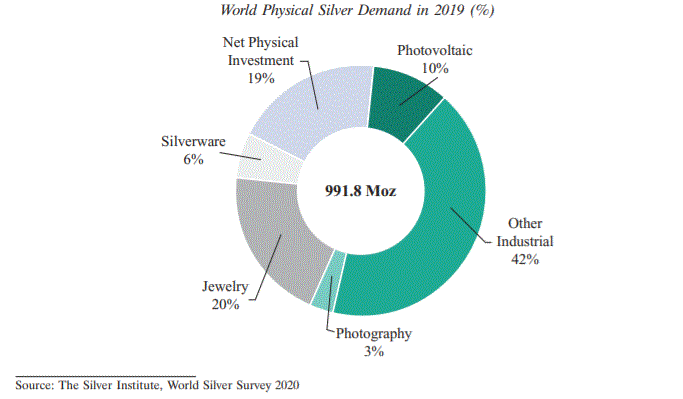The following content is excerpted from the prospectus of Sunshine Silver Mining & Refining Corporation (to be renamed Gatos Silver, Inc.) dated October 6, 2020 filed on SEDAR.
Silver Demand
The three principal drivers of silver demand are industrial applications, consumer use and
investment. According to The Silver Institute's World Silver Survey 2020, demand for industrial
applications is mainly driven by electrical and electronics uses, which accounted for 58.3% of industrial
demand and 30.0% of total demand in 2019. Jewelry accounted for 20.3% of total demand and net
physical investment represented 18.8% of total demand.
Silver demand grew 0.4% in 2019 to a three-year high of 991.8 million ounces, from 988.3 million
ounces the previous year, driven by a 12.3% surge in demand for net physical investment. This was
offset by declines in silverware and other industrials. Silver remains difficult to substitute in many areas,
and outside of a dip in 2009, demand for industrial applications has remained broadly flat since 2007.
There was healthy photovoltaic demand in 2019, with support from structural changes in demand, such
as vehicle electrification.

Source: Prospectus of Sunshine Silver Mining & Refining Corporation (to be renamed Gatos Silver, Inc.) dated October 6, 2020 filed on SEDAR.
 Industrial Applications
Industrial Applications
Traditional industrial applications of silver include batteries, bearings, brazing and catalysts. Silver,
which is the best conductor of electricity among all metals, is used in virtually all electronics. In
addition to traditional industrial uses, increases in emerging applications for silver, such as in the
electric powertrain and other applications that are increasingly featured in hybrid internal combustion
engine cars and electric vehicles, as well as LCD and RFID technologies, are expected to continue to
augment industrial demand. Emerging applications include the advent of flexible electronics in which
silver batteries play a prominent role, utilizing silver's reflectivity as a component in solar cells to
produce "green" electricity and utilizing silver's antimicrobial properties in medical applications and in
the prevention of algae build-up in water purification systems.
Global industrial demand, which represented 51.5% of total silver demand in 2019, totaled
511.5 million ounces, flat from 2018. A 6.7% increase in silver demand from the photovoltaic sector
was offset by an annual decrease in the electronics and electrical sector. Combined, China, the United
States and Japan accounted for 347.1 million ounces, representing 67.9% of total 2019 industrial
demand.
The electrical and electronics sector has consistently ranked as the largest source of industrial
silver demand. Silver's electrical and thermal conductive properties make it ideal for multiple
high-performance electronics and high voltage circuits, connectors and other electrical components,
which are all integral parts of electronics. Such uses include switches, contacts, fuses, superconductors
and printed circuit boards, which are contained in computers, mobile phones and other smart
technologies. According to The Silver Institute's World Silver Survey 2020, silver demand from the
electrical and electronics sector reached 297.6 million ounces in 2019. At 84.7 million ounces, Japan
accounted for 28.5% of 2019 electrical and electronics demand, with China (23.3%) and the United
States (21.0%) also accounting for significant demand.
Historically, photographic uses represented a large source of silver demand, accounting for 74% of
total silver demand in 1999. However, photographic use has since declined significantly, driven by the
transition from silver halide to digital technology, especially in the area of consumer film. In 2019,
photographic uses accounted for just 3.4% of total silver demand, according to The Silver Institute's
World Silver Survey 2020.
While photographic uses have declined, new technologies have emerged. For example, accelerated
growth in the solar panel market has contributed to silver industrial demand in recent years. Silver is
used both as a conductor in solar cells and as a reflector in mirrors used to concentrate solar energy.
Demand for silver from photovoltaics accounted for 19.3% of industrial demand and 10.0% of total
physical silver demand in 2019, according to The Silver Institute's World Silver Survey 2020.
More >>
Silver Market
 Silver Industry Overview >>
Silver Industry Overview >>
Silver is one of the eight precious, or noble, metals; the others are gold and the six
platinum-group metals. Silver occurs naturally in its solid metallic state and is commonly associated with deposits of gold, copper, lead and zinc as a secondary metal. Silver is distinct from other precious metals in that it is...
More >>
 Silver Supply >>
Silver Supply >>
Silver supply is primarily driven by mined silver production, which, according to The Silver
Institute's World Silver Survey 2020, accounted for 81.7% of supply in 2019. Recycling largely accounted
for the remainder of silver supply. Global silver supply increased 0.6% year-over-year in 2019 to 1,023 million ounces...
More >>
 Markets and Outlook >>
Markets and Outlook >>
The price of silver has experienced significant volatility over the last 25 years. The price of silver
averaged approximately $4.71/oz from 2000 through the end of 2003. Beginning in 2004, the price of silver began to appreciate considerably, reaching a high of $48.70/oz in April 2011. This significant ascent in the price of silver...
More >>